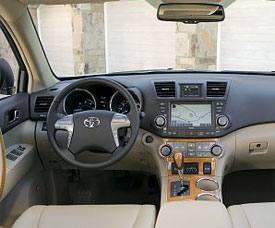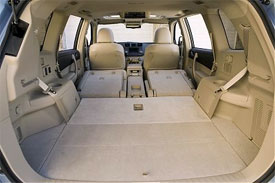2008 Toyota Highlander/Hybrid
As the first mid-size SUV using a car-derived unitized chassis and all independent suspension, Toyota’s Highlander proved family-sized sport-UTE’s didn’t have to be gas hogs. Paving the way for the crossover utility market, the Highlander was also the first mid-size utility to add a hybrid gasoline-electric drive train. Now, in its second generation, the all-new 2008 Highlander enters a market filled with crossover rivals. So, will it still stand out?
It will if buyers are looking for a nicely improved version of this popular mid-size crossover utility that’s still racking up impressive sales even after seven years!
The 2008 Toyota Highlander is indeed new from the wheels up, but its roots remain. The first Highlander was based on the Camry sedan, and the new one is, too. But for 2008, it’s the 6th generation Camry/Avalon chassis, which allows a Highlander that’s nearly 4-inches longer and 3-inches wider. Wheelbase is also increased by three to 109.8-inches, and that all goes into cabin space as the Highlander now has standard seating for seven.
The more substantial platform is clothed in more muscular body panels, with lines and blisters borrowed from the compact RAV4.
The nose wears a wide trapezoid grille, with different treatments for the hybrid and regular Highlanders. It’s set off by a big-pickup-style bumper that blends into prominent wheel arches, while the door bottoms tuck tightly into the lower sills, giving the impression of a narrow waist.
The tail is tall, with prominent high-set lights, a lift-gate with separate swing-up glass on Limited models, and a step bumper.
This bigger-bodied crossover rides on new 17-inch or 19-inch wheels which are now powered by V6s only; either the standard 3.5-liter dual-cam V6 with 270 horsepower and 248 pound-feet of torque, or the Hybrid’s gasoline-electric Hybrid Synergy Drive, which combines a 3.3-liter V6 with three high-torque electric motor/generators, and a nickel metal hydride battery pack. Maximum system output is also 270 horsepower, up 2, with 212 pound-feet of torque.
That extra pair-of-horsepower must move an additional 300-pounds of Highlander which the Hybrid does with standard electronic on-demand 4-wheel-drive. Gasoline-only Highlanders are still available in front or 4-wheel-drive.
Even with more power, fuel economy has been maintained. Adjusted Government Fuel Economy Ratings are 17 city and 23 highway with 4-wheel-drive. The Hybrid scores 27 city and 25 highway. And all run on regular grade gas.
We hit the road in a Hybrid at the Highlander’s national press introduction near Phoenix, and were suitably impressed with how well it moves. There may be an extra three bills of mass on board, but the drive train zipped it along as well as last year’s model.
 All Highlanders now have electronic steering, which is numb but quick. We did feel the weight more in corners, where the soft springs allowed the body to roll quite a bit. The front end exhibits the same strong plow as before, but ride quality is much improved. That is unless you opt for the gas-powered Sport model, which has more athletic handling, but at the expense of a much rougher ride.
All Highlanders now have electronic steering, which is numb but quick. We did feel the weight more in corners, where the soft springs allowed the body to roll quite a bit. The front end exhibits the same strong plow as before, but ride quality is much improved. That is unless you opt for the gas-powered Sport model, which has more athletic handling, but at the expense of a much rougher ride.
Driving aids include standard Vehicle Dynamics Integrated Management, which ties together stability and traction controls, braking, and steering.
Also standard is Hill-Start Assist Control, with Downhill Assist included on non-hybrid 4x4s.
Inside, the latest Highlander is roomier with richer trim. The dash layout is busier than before, however, and on our pre-production example were rather utilitarian plastics.
The center stack has been totally revised. There’s a small LCD driver-information display up top and below that on our tester a much larger screen for navigation, the back-up camera, and energy use.
The new economy driving indicators in the main gauge cluster are useful but distracting. New ECON DRIVE MODE limits aggressive acceleration, while this EV Mode switch locks the hybrid in electric drive for low speeds.
Safety is comprehensive with seven airbags. The three-way split second-row seats now feature a removable center section for walk through capability. It neatly stores under the front console.
 The second-row passenger side section also tilts and slides for improved access to the third-row seat. More wheelbase means more leg room here, although it’s still mostly for kids. Cargo volume behind the third row remains small at 10.3 cubic feet. Fold the third row and it jumps to 42.3 cubic-feet. Use the handy remote releases and fold the second row for a big 94.1 cubic feet. 2008 Highlander prices have not yet been released, but with a V6 and third row now standard, we expect them to start at about $28,000 with front-wheel drive, and $29,500 with four-wheel drive. With no front-drive price leader, four-wheel drive Hybrid prices should start near $35,000.
The second-row passenger side section also tilts and slides for improved access to the third-row seat. More wheelbase means more leg room here, although it’s still mostly for kids. Cargo volume behind the third row remains small at 10.3 cubic feet. Fold the third row and it jumps to 42.3 cubic-feet. Use the handy remote releases and fold the second row for a big 94.1 cubic feet. 2008 Highlander prices have not yet been released, but with a V6 and third row now standard, we expect them to start at about $28,000 with front-wheel drive, and $29,500 with four-wheel drive. With no front-drive price leader, four-wheel drive Hybrid prices should start near $35,000.
The 2008 Toyota Highlander doesn’t offer any big headlines firsts, but it does deliver more of everything that made the original Highlander such an enduring success.
And in a market now crowded with crossover rivals inspired by the first Highlander, it’s enough to guarantee that the 2008 Highlander will be another Toyota triumph.
Specifications
- Hybrid Engine: 3.3-Liter V6high-torque Electric Motor/generatorsnickel Metal Hydride Battery Pack
- Horsepower: 270
- Torque: 212 Lb Feet
- EPA: 27 MPG City/ 25 MPG Highway






